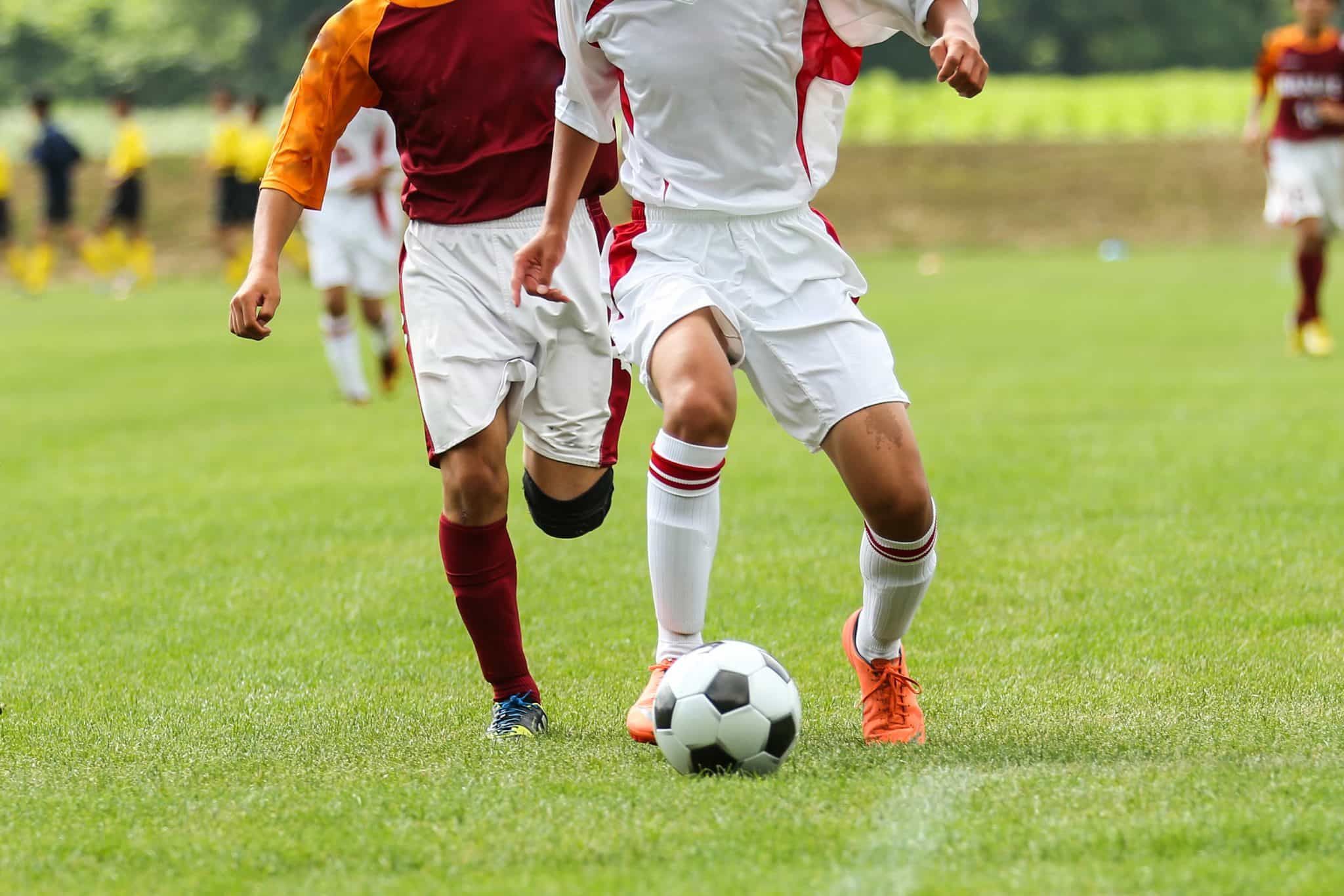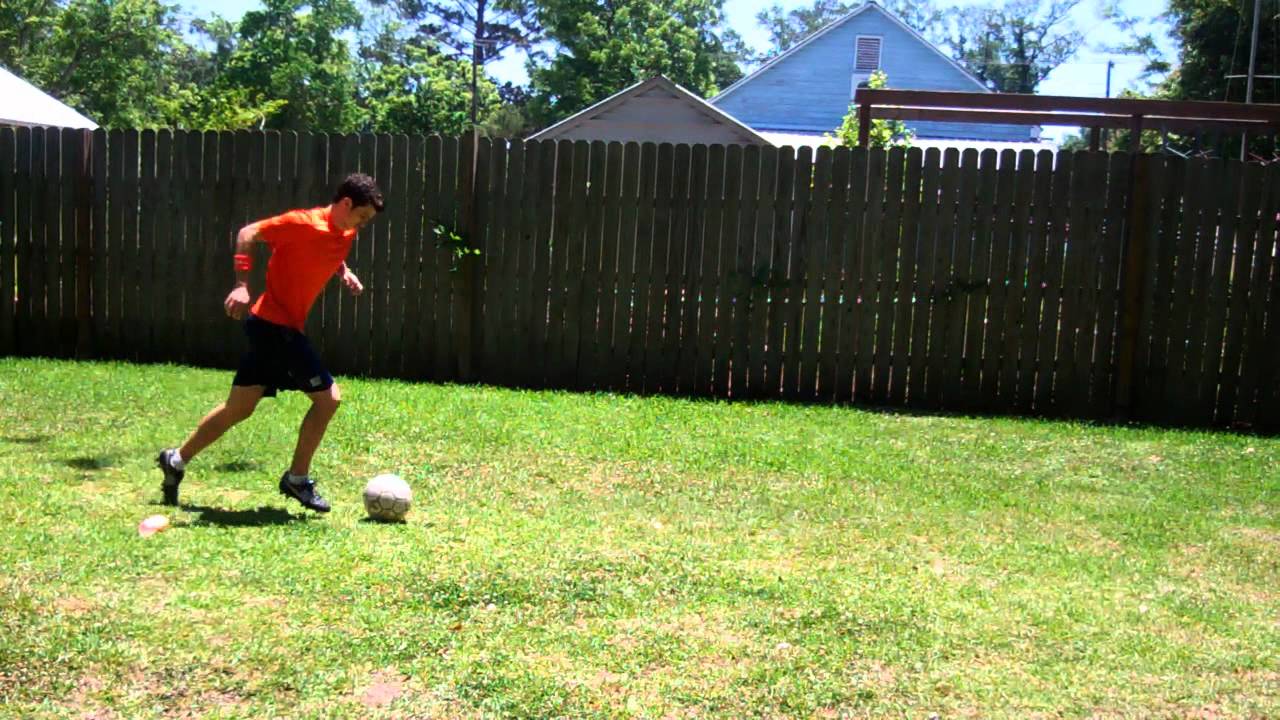To dribble a soccer ball, use quick touches with your feet to maintain control and maneuver around opponents. Learning how to dribble a soccer ball effectively is a crucial skill for any player on the field.
Being able to maneuver past opponents and maintain control of the ball can significantly influence the game’s outcome. Dribbling involves using quick, precise touches with your feet to keep the ball within your control. It requires a combination of agility, coordination, and ball awareness, allowing you to react quickly to changing situations on the field.
In this guide, we will break down the key techniques and strategies to help you improve your dribbling skills and become a more effective player.
Mastering The Fundamentals
When it comes to mastering the art of dribbling a soccer ball, it all starts with getting the fundamentals right. These basic skills build the foundation for more advanced techniques and help you become a more effective player on the field. In this section, we will dive into the key aspects of mastering the fundamentals of dribbling, including basic body positioning, using the inside of your foot, and maintaining control with close touches.
H3basic Body Positioning/h3
Proper body positioning is crucial for effective ball control while dribbling. When you approach the ball, make sure your body is square to the ball, with your knees slightly bent and your weight evenly distributed. This balanced stance will allow you to move quickly in any direction and maintain better control of the ball.
One important aspect of body positioning is keeping your head up and your eyes on the field. This will help you anticipate the movements of your teammates and opponents, allowing you to make better decisions on the field and avoid losing possession of the ball.
H3using The Inside Of Your Foot/h3
Using the inside of your foot is the most common technique for dribbling the ball. To use the inside of your foot, plant your non-dominant foot next to the ball and make contact with the ball using the inside of your dominant foot. The inside of your foot provides a larger surface area to make contact with the ball, giving you better control and precision when dribbling.
Keep in mind that the angle at which you make contact with the ball will determine the direction of your dribble. If you want to dribble straight ahead, make contact with the ball near the center. If you want to change direction, angle your foot slightly to the left or right to guide the ball in the desired direction.
H3maintaining Control With Close Touches/h3
Maintaining close touches on the ball is essential for tight dribbling control. The closer the ball stays to your feet, the more difficult it becomes for defenders to steal it from you. To achieve close touches, practice keeping the ball within a small radius of your feet while dribbling.
Use short strides when running with the ball and take quick, small touches to keep it close. This will allow you to change direction rapidly and react to the movements of defenders more effectively. Remember to stay light on your feet and maintain good body positioning to maximize your control and agility.
By mastering these fundamental techniques of dribbling, you can enhance your ball control skills and become a more confident and effective soccer player. With consistent practice and dedication, you’ll be able to dribble past your opponents with ease and make crucial plays on the field.

Credit: completesoccerguide.com
Improving Technique
Improving your technique is crucial when it comes to dribbling a soccer ball. Having strong dribbling skills can make you a formidable player on the field. In this section, we will explore three key aspects of improving your technique: developing agility and balance, utilizing the outside of your foot, and practicing change of direction moves.
Developing Agility And Balance
In order to become a skillful dribbler, you need to develop agility and balance. These qualities will allow you to maneuver through tight spaces and maintain control of the ball. Here are some methods to improve your agility and balance:
- Perform cone drills: Set up a series of cones in a straight line or zigzag pattern. Dribble the ball through the cones, focusing on shifting your body weight and changing directions quickly.
- Engage in ladder drills: Use an agility ladder to work on your footwork. Practice different movements such as quick steps, side shuffles, and crossover steps.
- Include balance exercises: Incorporate exercises like single-leg squats, calf raises, and standing on one leg to improve your balance. These exercises will help you stay grounded and stable while dribbling.
Utilizing The Outside Of Your Foot
The outside of your foot can be a powerful tool when it comes to dribbling. By using the outer edge of your foot, you can control the ball with precision and execute quick changes in direction. Here are some tips on how to utilize the outside of your foot:
- Practice touch and drag moves: Place the ball slightly in front of you. Using the outside of your foot, touch the ball lightly and then quickly drag it to the side. Repeat this motion to get comfortable with the technique.
- Master the outside cut: While running with the ball, push the ball slightly forward and use the outside of your foot to cut the ball in the opposite direction. This move is effective for evading defenders and changing the direction of play.
- Combine with other dribbling techniques: Experiment with combining the use of the outside of your foot with other dribbling moves, such as step-overs or feints. This will keep your opponents on their toes and enhance your overall dribbling prowess.
Practicing Change Of Direction Moves
Being able to change direction quickly during a dribble can give you a significant advantage on the field. It allows you to evade defenders, create space, and keep possession of the ball. Here are some change of direction moves to practice:
- Master the inside-outside cut: With the ball at your feet, quickly cut the ball to the inside with the inside of your foot, then swiftly change direction by pushing the ball to the outside with the outside of your foot.
- Perfect the step-over: Fake a change in direction by swinging your leg around the front of the ball without touching it. This move can deceive defenders and create opportunities to move past them.
- Work on the stop and start: When running towards a defender, suddenly stop the ball with the inside of your foot and then explode in the opposite direction. This move can catch defenders off guard and create space.
By focusing on developing agility and balance, utilizing the outside of your foot effectively, and practicing change of direction moves, you can greatly enhance your dribbling technique. Remember, consistent practice and dedication are key to mastering these skills and becoming a formidable dribbler on the soccer field.
Mastering Advanced Skills
Learn the art of dribbling a soccer ball like a pro in this comprehensive guide. Discover advanced techniques and strategies to enhance your ball control skills on the field.
When it comes to the game of soccer, dribbling is an essential skill that every player must master. However, basic dribbling techniques can only take you so far. To truly excel on the field, it is important to develop advanced dribbling skills. In this section, we will explore three key aspects of mastering advanced skills in dribbling: speed dribbling techniques, shielding the ball from defenders, and executing effective turns and cuts.Speed Dribbling Techniques
Speed dribbling is an invaluable skill that allows players to maintain control of the ball while moving at high speeds. It involves using quick touches and precise footwork to maneuver past opponents and create scoring opportunities. To master speed dribbling, here are some key techniques to focus on:
- Maintain a low center of gravity by slightly bending your knees. This will give you better balance and allow for quick changes in direction.
- Use the outside and inside of your feet to control the ball, allowing for greater versatility and control.
- Practice your acceleration and deceleration skills to quickly change pace and leave defenders in your wake.
- Utilize different moves such as the step-over, the scissors, or the Matthews cut to deceive defenders and create space for yourself.
Shielding The Ball From Defenders
Shielding the ball effectively is crucial for fending off opposing players and maintaining possession. It involves using your body as a shield, using your arms and legs to create a barrier between the ball and the defender. Here are some tips for mastering this technique:
- Position your body between the defender and the ball, using your arms to create space and protect the ball.
- Keep your body low and balanced, making it difficult for the defender to dispossess you.
- Use your hips and shoulders to maintain your position and fend off pressure from the opposing player.
- Anticipate the defender’s movements and adjust your body position accordingly to keep them at bay.
Executing Effective Turns And Cuts
Turns and cuts are essential techniques for quickly changing direction and evading defenders. They allow you to create space and open up passing or shooting options. Here are some key tips for executing effective turns and cuts:
- Practice the drag-back, the spin turn, and the inside/outside cut to develop your turning skills.
- Be decisive with your movements, using sharp and explosive turns to catch your opponents off guard.
- Keep your head up and maintain awareness of your surroundings to anticipate the best moment to execute a turn or cut.
- Use your body feints and fake movements to deceive defenders and create space for yourself.
Boosting Dribbling Confidence
Dribbling is an essential skill in soccer that allows players to maintain possession of the ball while maneuvering around opponents. Yet, many players struggle with confidence when it comes to dribbling. Whether you’re a beginner or an experienced player, boosting your dribbling confidence can greatly enhance your performance on the field. In this article, we’ll explore three key areas to focus on in order to build your confidence on the dribble:
Building Fitness And Endurance
Physical fitness is vital for effective dribbling. When you’re fit, you have more energy to sustain your movements, make quick decisions, and react appropriately to different game situations. Here are a few tips to boost your fitness and endurance:
- Engage in regular cardiovascular exercise such as running or swimming to increase your stamina.
- Incorporate interval training into your fitness routine to improve your speed and agility on the field.
- Include strength training exercises, such as squats and lunges, to enhance your leg muscles and overall body strength.
Developing Spatial Awareness
Having a good understanding of the space around you is crucial for effective dribbling. Spatial awareness helps you anticipate the movement of your opponents and make precise dribbling decisions. Here are a few ways to develop your spatial awareness:
- Practice dribbling in tight spaces to improve your close control and reaction time.
- Work on dribbling drills that involve changing direction quickly, such as figure-eight drills.
- Play small-sided games with limited space, forcing you to adapt and make quick decisions.
Expanding Your Dribbling Repertoire
To boost your dribbling confidence, it’s essential to have a diverse range of dribbling moves in your repertoire. The more moves you have, the more confident you’ll feel when facing opponents. Consider the following tips to expand your dribbling repertoire:
| Move | Description |
|---|---|
| Inside Cut | A quick change of direction using the inside of your foot. |
| Outside Cut | A sharp cut to the outside using the outside of your foot. |
| Step Over | A deceptive move where you fake a pass or shot by stepping over the ball. |
| Roll-Over | A move where you roll the ball from the inside of one foot to the outside of the other foot. |
| Drag Back | A move where you drag the ball backward with the sole of your foot. |
By practicing and mastering different dribbling moves, you’ll be able to confidently navigate through defenders and maintain possession of the ball.
Boosting your dribbling confidence in soccer requires a combination of physical fitness, spatial awareness, and a diverse range of skills. By dedicating time and effort to these areas, you’ll be well on your way to becoming a more confident and effective dribbler on the field.
Game-time Strategies
Dribbling is a fundamental skill in soccer that can make all the difference in a game. Being able to maneuver the ball effectively past defenders and create scoring opportunities is an essential skill for any soccer player. However, successful dribbling requires more than just raw talent; it requires strategic thinking and the ability to adapt to different game situations. In this section, we will explore some game-time strategies that can enhance your dribbling skills and take your game to the next level.
Dribbling In Different Game Situations
One crucial aspect of dribbling is the ability to adapt to different game situations. Every game is unique and presents different challenges, so understanding how to dribble effectively in each scenario is essential. Let’s take a look at some common game situations and how you can use dribbling to your advantage:
- 1. One-on-One Duels: When you find yourself in a one-on-one situation with a defender, use your dribbling skills to outwit your opponent. Keep the ball close to your feet, use quick changes of direction and pace, and use your body to shield the ball from the defender.
- 2. Tight Spaces: In crowded areas of the field where space is limited, tight ball control becomes crucial. Focus on short, quick touches to keep the ball within your control and use feints and small shifts in body weight to create separation from defenders.
- 3. Open Spaces: When you have ample open space, use your dribbling skills to accelerate past defenders and create scoring opportunities. Take advantage of the open field by maintaining control of the ball, using longer strides, and utilizing powerful bursts of speed.
Recognizing And Exploiting Space
Another important game-time strategy is the ability to recognize and exploit spaces on the field. Identifying gaps in the defense and utilizing them to your advantage can give you a significant edge when dribbling. Here are some tips on recognizing and exploiting space:
| Recognizing Space | Exploiting Space |
|---|---|
|
|
Combining Dribbling With Passing And Shooting
While dribbling is a fantastic skill on its own, combining it with passing and shooting can elevate your game even further. The ability to seamlessly transition from dribbling to passing or shooting adds dynamism to your gameplay and keeps defenders guessing. Here are some ways you can combine dribbling with passing and shooting:
- Use dribbling to draw defenders towards you, creating space for a teammate to receive a pass in a better position.
- When near the goal, use dribbling to maneuver into a scoring position and unleash a powerful shot on target.
- Practice dribbling in one direction, then quickly change direction with a pass to a teammate, catching the defense off-guard.
- Use dribbling to create openings for through balls, allowing your teammates to make runs and potentially score.
By incorporating passing and shooting into your dribbling repertoire, you become a more versatile and dangerous player on the field.
Frequently Asked Questions Of How To Dribble A Soccer Ball
How Do I Improve My Soccer Dribbling Skills?
To improve your soccer dribbling skills, practice regularly with a focus on controlling the ball close to your feet. Work on your agility, change of direction, and keep the ball under control at varying speeds. Use cones or markers to create an obstacle course for added challenge.
What Are Some Basic Dribbling Techniques In Soccer?
Basic dribbling techniques in soccer include using the inside and outside of your foot to control the ball, keeping it close to your feet, and using quick touches to change direction. Practice dribbling in different situations, such as while running, turning, or shielding the ball from opponents.
How Can I Maintain Better Ball Control While Dribbling?
To maintain better ball control while dribbling, keep your eyes up to anticipate the next move and be aware of your surroundings. Use your body as a shield between the ball and opponents. Work on improving your balance, coordination, and touch by practicing with both feet.
Conclusion
Mastering the art of dribbling a soccer ball is essential for any aspiring player. By following these step-by-step instructions, you can improve your ball control and maneuverability on the field. Remember to keep practicing and always strive for improvement. With techniques like using the inside and outside of your foot, maintaining balance, and utilizing quick changes of direction, you’ll be able to outwit opponents and create scoring opportunities.
So grab your soccer ball and get dribbling!

General Manager & Auditorial Head.
Killian Jake is a World Sports Traveler and hobbyist sports lover. By exploring different sorts of playing modules like indoor, outdoor, and many more. As for professionalism and writing, it’s helpful to give you the right suggestions on different games and sports.





